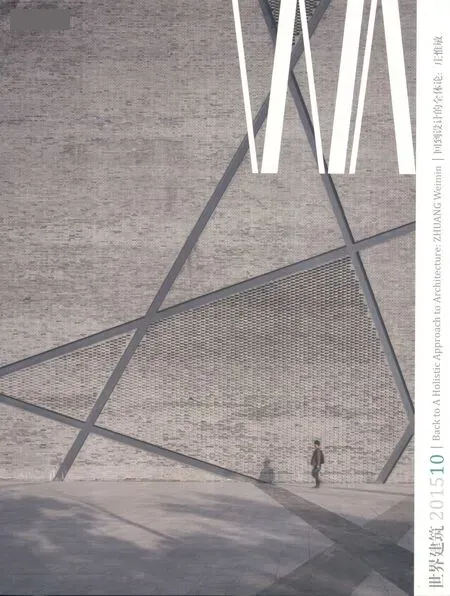玉树州行政中心,青海,中国
玉树州行政中心,青海,中国
Yushu Administrative Center, Qinghai, China, 2014
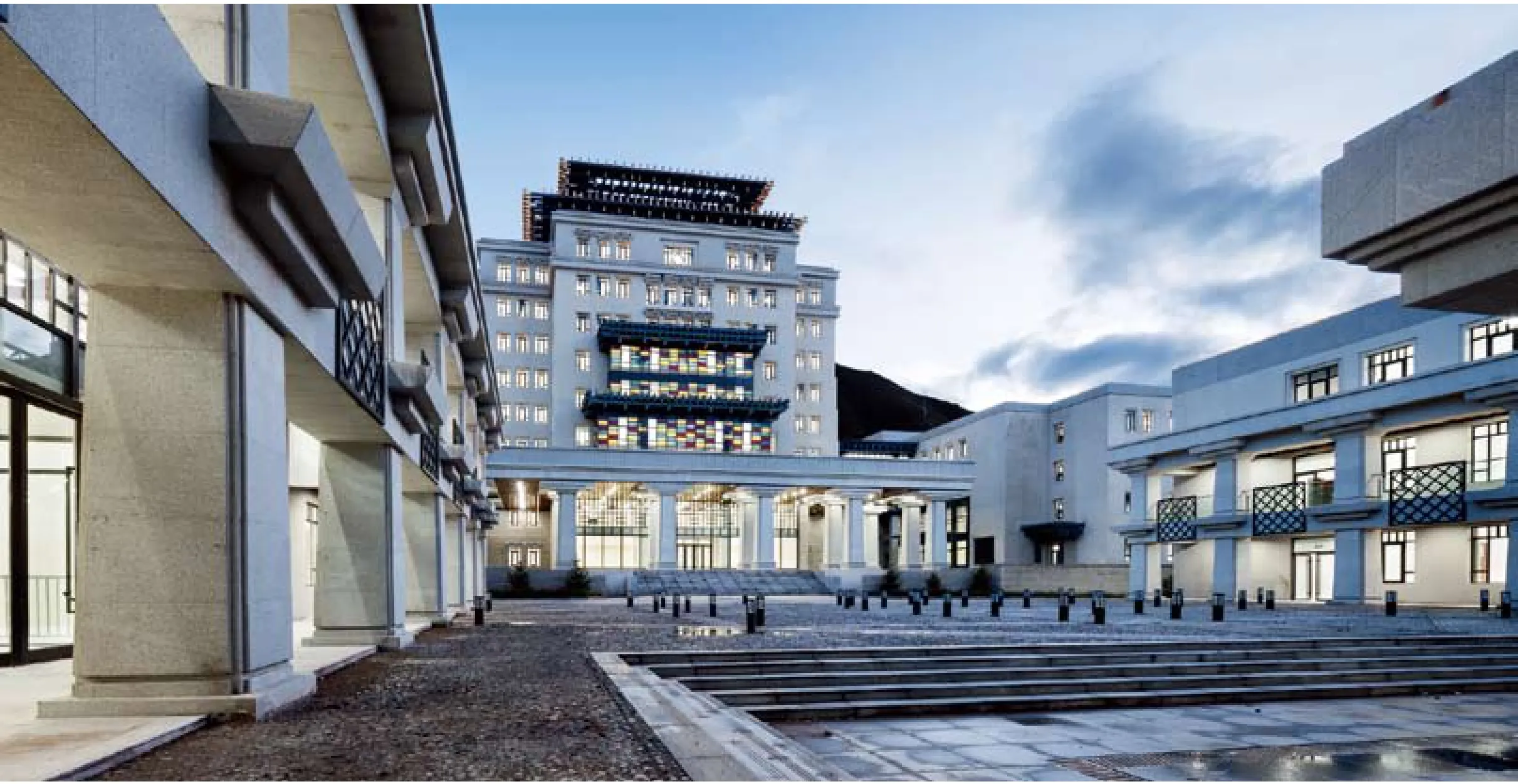
1 州政府主楼/Main building of State government
青海玉树位于青藏高原腹地,玉树地震灾后重建活动是迄今人类在高海拔的生命禁区开展的最大规模灾后重建,该项目是玉树地震灾后重建的十大重点项目之一。在前期对藏区院子的调研中,建筑师发现藏式建筑院落空间组合多样、变化无穷,往往有较为明显的高差变化,追求纵向延伸、依托于整体山势益显气势磅礴,形成院中有院、步行景异、高低变幻、错落有致的空间序列。在藏式建筑内部,廊院依次递接、疏密有致,尺度宜人,个体和环境形成一种默契的对话,巧妙地与自然景观相融合。藏民在这样的院子中一边唱着歌一边干着活,建筑是在这种情绪中营建出来的,这些正是建筑师所追求的感人场所。
玉树州行政中心有两个特质:一是藏文化中的宗山意象,要有一种权力的象征;二是通过藏式院落表达的当代行政建筑需在内涵上亲民。这两者是有矛盾的,如何解决就是我们设计的要点。建筑整体的调子淡雅质朴,不凸显宗教色彩,通过整体造型和空间院落表达上述两方面特质。设计的特点是含蓄中显力度,亲切又不失威严。
作为“雪”的院子
建筑设计方案吸取了藏式“宗山”建筑的特点,从地域特征、民族历史文化中寻找建筑的原型。“宗”为旧制中西藏地方政府的行政机构,由于当时西藏政教一体,宗和宗教结合十分紧密,“宗”建立在山头之上,也就形成了“宗山”。宗山周围有层层叠叠的附属用房环绕,形成鲜明的层次和丰富的水平肌理,称为“雪”。设计方案充分利用地形高差勾勒富有趣味和内涵的院落空间:阳光投入静谧的内院,落在石子铺成的吉祥纹样上;在大树庇佑下的院子里观赏蓝天下的普措达泽神山;在带有康巴藏族风格的花窗前感受心灵的涤荡。主体建筑位于中央,庄严挺拔,作为“雪”的院落层叠交错,尺度宜人。“宗”“雪”相映,烘托出建筑群体的气势。
柱廊的表达
玉树州行政中心的柱廊,赋予院子空间以叙事性。这是一种发自内心的表达,表达的是一种氛围和意境,一种场所感。无论是入口处开放式的文化展廊,还是层层上升的台地院落、半开放的休憩庭院等,构成了连续而又独特的空间体验。在柱廊穿行可以看见保留的州委小楼、历届书记种植的小树林、远方的结古寺、一个又一个的内部庭院。特别是行政中心入口让内部院落开向德吉娘神山和扎曲河圣水,自然地串接起城市与建筑之间的联系。人们穿行柱廊的过程中,历史的故事和个体感受,串联起各种偶然“事件”的微观叙事,自动生成出内涵丰富、可读性强的场所。
水院“玉树”
位处三江源的玉树院落怎能没有水景?在本方案的院落空间中因地制宜地布置一些水院,水院倒映出周边的自然环境,也倒映出建筑上富有藏式意味的牛角窗框和边玛墙。玉树气候严寒干燥,树木生长十分缓慢,当地每一棵大树都可以称之为“玉树”。在本项目场地中有结古镇上为数不多的高大乔木,十分珍贵。设计团队对这些树木的位置和冠径仔细核实,并在设计中予以保留,所有建筑都对它们进行避让,体现出对环境的尊重。水静风平,玉树相映,构成一幅优美的雪域高原“林卡”意象。
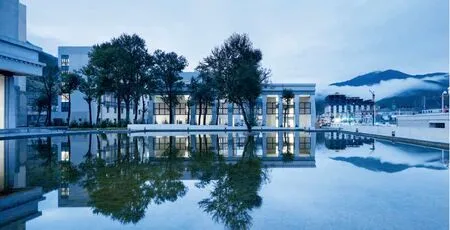
2 水院倒映的保留树木和远山/Water reflection of preserved trees and far mountains
当地建构
在项目设计和施工过程中,设计团队30多批次赴玉树藏区实地调研,并积极向藏学研究专家和当地工匠学习请教,在现代建筑技术和工艺条件下最大程度上尊重藏区当地的风俗文化,体现当地文脉特色。寺庙喇嘛制作的“玻璃尕层”,是对当地藏区窗户的抽象表达。当地工匠砌筑的劈裂砌块,体现了藏式建筑的厚重粗矿。采用涂料拉毛处理的女儿墙,既富有边玛草的韵味又符合当代工艺。藏区妇女铺砌卵石铺地,一边欢唱一边工作。这样的地方建构赋予建筑群落生命力和情绪,营建出超越视觉的空间感受。
青藏高原的大开大阖,雪域神山的鬼斧神工,铸就了藏区建筑的雄浑品质。巍巍昆仑山,茫茫唐古拉,在大自然壮美面前,建筑师对神山圣水一直秉持敬畏之心。在普措达泽山下,藏式院子和神山、圣水、玉树融为一体,创建和自然、历史、未来可能的对话。□

3 总平面/Site plan
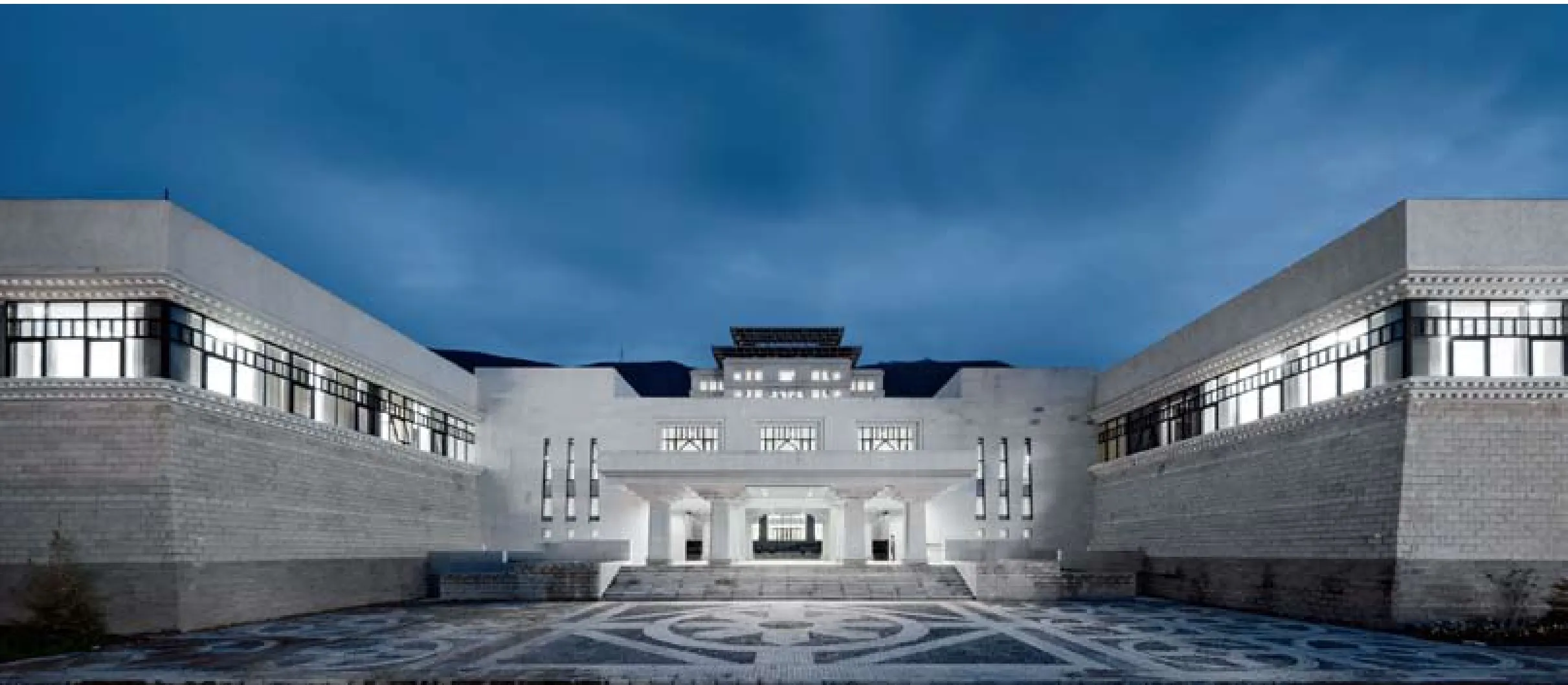
4 州政府入口/State government entrance
Located in Qinghai province, Yushu lies in the hinterland of the Qinghai-Tibetan Plateau. The post-disaster reconstruction of Yushu was the largest ever high-altitude reconstruction project in human history. At the beginning of the research of Tibetan courtyards, the architects found that they often have diverse patterns, significant changes in elevations, and are typically extended longitudinally. With these features, combined with their unique geographical location, the Tibetan courtyards look magnificent. Inside these buildings, the courtyards are one after another with considerable density and size. these features and the environment perfectly fit together, harmoniously coexisting with the natural setting. Tibetans sing and work in these courtyards. Buildings, created in a harmonious and warm atmosphere, is the object of which architects pursue.
The Yushu Administrative Center can be described in as two words: "power" and "civilian". "Power" means that the building acts as an administrative symbol. "Civilian" means that the government must be close to its people. As the matter of fact, these two words usually contradict each other. How to solve this contradiction is what we focused on in this design. Basically, the building's style should be simple and elegant. Religious symbolism should be avoided. In this case, the characteristics of "power" and "civilian" can be expressed through the design of the building's courtyards and its overall massing. All in all, the design should be modest but powerful at the same time.
Courtyard named "snow"
The design is based on the Tibetan Dzong typology, and we examined these precedent buildings due to local geographical and cultural characteristics and the historic Tibetan culture. In the past, Dzongs acted as the administrative centers of Tibetan local governments. Government and religion were tightly related, due to the fact that back then, the Tibetan government integrated temporal and spiritual power. In the past, Dzongs were built on the tops of mountains, a so-called "Dzong Mountain". There were many of attached houses surrounding each Dzong Mountain, these formed into a distinct hierarchy of levels and a diverse horizontal texture. The houses around a Dzong Mountain were known as snow. Our design made full use of changes in elevation, so as to present a fun and interesting nature to the building. We intended to convey an experience, whose narrative is as follows. "the sun shines brightly on the quiet courtyard, making the texture of paths made of pebbles glitter. Enjoy Potatso Mountain, which is embedded in the blue sky, under the shadow of the big tree in the courtyard. Feel your heart which is touched by the beauty of Tibetan style window design. The main building lies in the middle surrounded by the courtyard called snow."
The expression of the colonnade
In the Yushu Administrative Center, The colonnade seems to tell a story to us, which was written from the heart and represents the atmosphere and mood of the space. The entrance, featuring a the culture exhibition gallery, the platform courtyard, and the semi-open courtyard constitute a continuous space that intends to bring people unique feelings. Walking along the colonnade, we can see the previous government building, the distant JieGu Temple, groves of trees that previous Secretaries planted, and internal courtyards placed one after another. the entrance of the government office faces DeJiNiang mountain and the ZhaQu river, reinforcing the natural connection between the city and the building. As people walk through the colonnade, their individual feelings and historical stories string together and become parts of a length narrative.
Yushu courtyard with water
Since Qinghai is located at the source of three rivers (the Yangtze River, the Yellow River, and the Mekong River), there should obviously be a water feature. Within the courtyard spaces, we provided water features according to the local conditions, which reflect the natural environment, the Tibetan oxhorn window frames, and the Bianma grass wall. In Yushu, the weather is cold and dry, and these trees grow very slowly, so every big tree can also be called "Yushu". There are a small number of mature trees located throughout the site, which are very precious. Our design team did careful research on their position, as well as the diameters of their crowns. these trees would be preserved and the complex avoided them to show our respect to nature. the tranquil waters and the bright trees have created a beautiful snowfield "LingKa (garden)" image.

5 西配院水景/Water scenery at western courtyard
Locally Constructed
In the process of program design and construction, our team traveled to the Yushu Tibetan area more than thirty times for field surveys, and to consult Tibetan historians and local artisans. Within the limits of modern architectural technology and technique, we respected the local customs and exhibited local cultural characteristics. The traditional window lintels, handcrafted by Buddhist monks, implicity express the local Tibetan style. The building blocks were made by local craftsmen, and reflect the massive Tibetan architecture. Parapets were decorated by paint, and have the combined charm of Bianma grass and contemporary technology. Tibetan women enjoyed singing while paving the pebble floor. The construction process provided the building as well as the surrounding community with a kind of vitality and emotion that is more profound than mere visual stimulation.
The beauty of the Qinghai-Tibetan Plateau is a wonder of nature, which also contributes to the elegance of the Tibetan style of architecture. The spectacular Kunlun Mountain and Tanggula Mountain, whose beauty is beyond words, are a feast for the eyes. Facing these magnificent sights, architects are doing their job with earnest reverence for nature. In the arm of Potatso Mountain, Tibetan courtyards harmoniously lie with the mountains, rivers and trees. They are communicating with nature, history and the future.□
项目信息/Credits and Data
项目负责人/Principal in Charge: 庄惟敏/ZHUANG Weimin
设计团队/Design Team: 庄惟敏,张维,姜魁元,龚佳振,屈张等/ZHUANG Weimin, ZHANG Wei, JIANG Kuiyuan, GONG Jiazhen, QU Zhang, et al.
场地面积/Site Area: 63,300m2
总建筑面积/Total Floor Area: 72,638m2
建筑高度/Height: 45m
设计时间/Design Period: 2010-2011
竣工时间/Completion: 2014
摄影/Photos: 姚力/YAO Li

6 首层平面/Floor 0 plan

7 南立面/South elevation
评论
汤朔宁:普措达泽山下的新建筑
在如今我国快速城市化进程中,如何使新建建筑免于国际范式的同质化影响,孕育与生俱来的气质并与环境相长而生?玉树州行政中心设计从玉树地区特有的神山圣水人文地理环境入手,尊重高原藏地文化,打破了我国行政办公建筑规模巨大、尺度恢宏、轴线对称等设计范式,以神山普措达泽山为背景,圣水澜沧江发源之扎曲河为依托,将化整为零的行政中心之“宗山”建立在依据地形而建的层叠藏式院落的“雪域”之上,“须弥不动住中央”的雪域宗山形象呼之欲出而又融入环境。玉树州行政中心纯净洁白的柱廊、层层上升的台地院落、临水而设的开放庭院构成了不断唤回历史记忆的生活化场景,在庄重中更凸显亲民。建筑师对于藏族传统文化的尊重也在细部中得到体现,边玛墙、梯形套窗、松格门框、玻璃尕层、吉祥图案的鹅卵石、熠熠发光的金色拱柱与故址上精心留存的贵玉之树,形成了印刻在记忆中的深深印记。在这里,场所精神根植于场地自然特征之上,时间与空间、人与自然、现世与历史融合在一起的场景,成为了镌刻着玉树人思想与感情烙印的“心理文化地图”。普措达泽山下的这一新建筑正如吉祥白月,照耀与保护着震后重生的玉树。
Comments
TANG Shuoning: the new building at the foot of the Potatso Mountain
How do architects design buildings according to their inherent nature and maintain the existing appearance of their surroundings, while avoiding the global phenomena of assimilation and imitation which an urbanized China has generally followed? The Yushu Administrative Center has been designed based on Tibetan cultural characteristics, and shows respect for the Tibetan plateau culture. This design broke the routine of administrative building designs in China, typified by huge, magnificent and symmetrical masses. The Yushu Administrative Center utilized Potatso Mountain as a backdrop, and the center of the complex was built along the Zhaqu River, which is the source of the Mekong River. this approach allowed a decentralized government complex, or Dzong, which was built above the Tibetan-style courtyard, to sit atop a snowy land. In this way, the imagery of the Dzong in the snow is able to be vividly portrayed, yet allows it to fit well within its surrounding environment. It is like the Buddhist verse; "Sumeru remains firm but lies in the center".
the pure white colonnade, the terraced yard, and the open-plan courtyard of the Yushu Administrative Center creates a scene of local life, and also recalls a sense of the past and its rich history. the decision to include historic features in the design of this building endears it to the locals. The architects that were involved in this work paid reverence to the traditional Tibetan culture, and is reflected in the details of the design. Examples of this include Bianma grass walls, trapezoidal windows, latticed doorframes, traditional window lintels, auspicious patterns in the cobblestones, glittering golden buttresses, and carefully maintained and preserved trees. this emphasis and consideration for traditional design has the effect of imprinting itself into the people's consciousness.
the architect seeks to maintain the natural spirit, or genius loci, of this structure. Time and space, man and nature, and present and past have all been gathered together to draw a map of Yushu culture, imbued with the thoughts and emotions of the locals.
the new building at the foot of Potatso Mountain is like a bright moonlight, it illuminates and protects post-earthquake Yushu. (English translation by Dandan WANG)

8 入口门廊文化展厅/Cultural exhibition of entrance porch

9 鸟瞰/Bird's eye view

10 内院/Courtyard
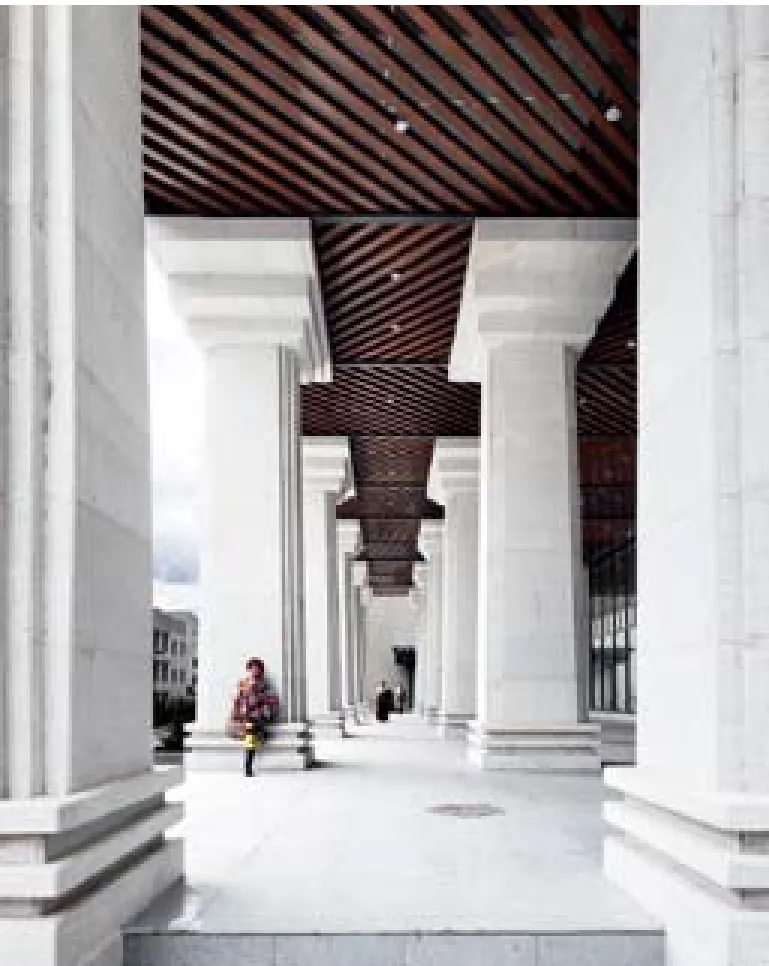
11 主楼廊柱/Porch of main building
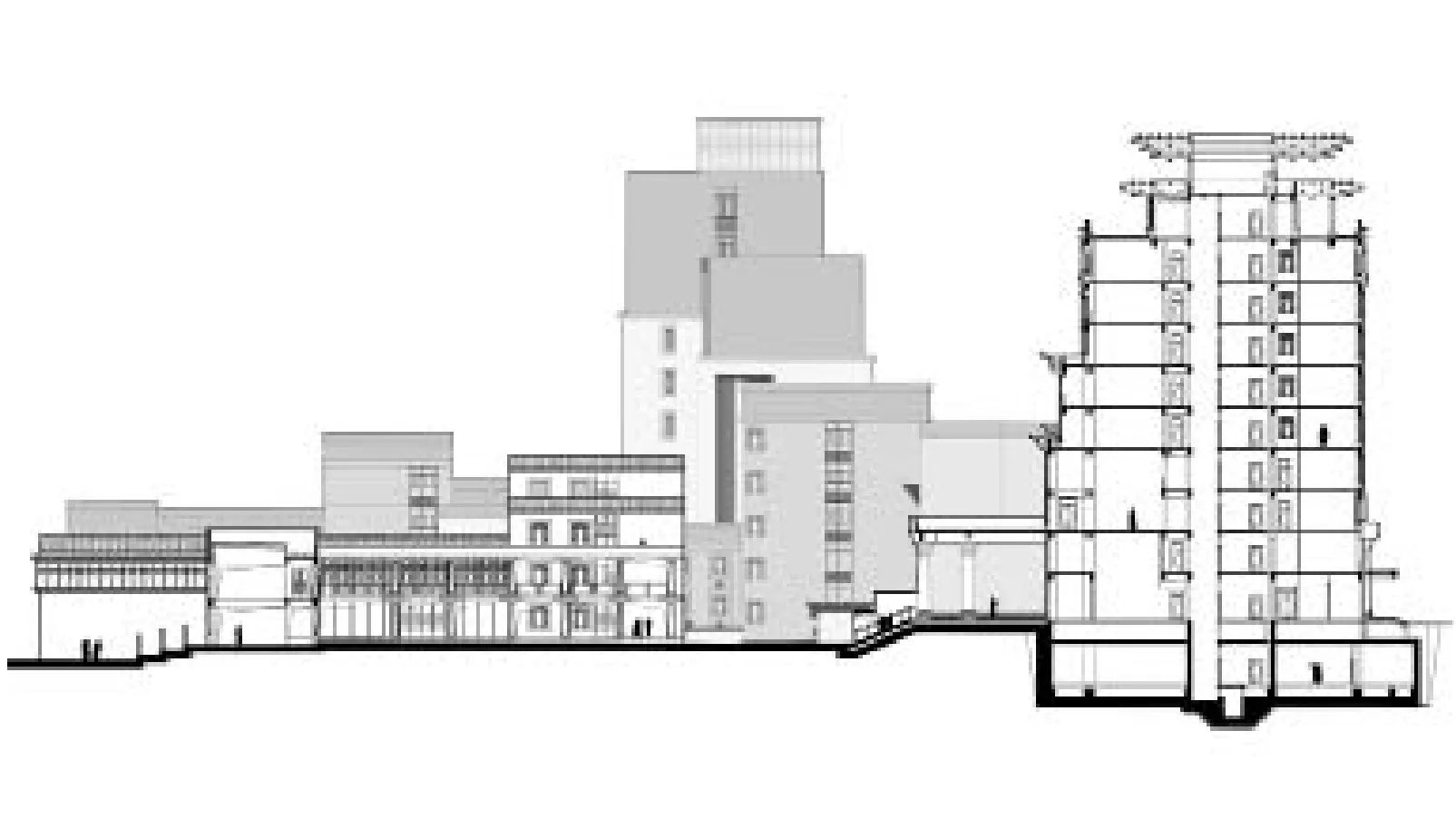
12 剖面/Section

13 劈裂装饰混凝土砌块墙体/Splitting decorative concrete block wall

